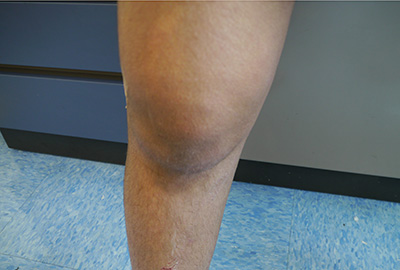
A 10 year old girl is brought to your office with complaints of right knee pain. She and her mother are not sure when this started, but she thinks something has been wrong for a few weeks. Her knee symptoms are worse first thing in the morning, but by lunchtime she is better. This does not seem to be keeping her from activities, but mom thinks she limps when she runs. She has not been ill recently, has had no fevers, no rashes or any other symptoms. There is no known history of trauma. Past medical history is unremarkable. Family history finds no rheumatoid arthritis or other autoimmune diseases.
- This child’s knee pain falls best into which major category of pain?
- inflammatory
- mechanical
- bony
- neuropathic
- Which of the following pairs of exam findings would be most consistent with this category of pain?
- erythema overlying the knee, difficulty weight bearing
- hyperextension, significant pain with walking
- loss of visual landmarks, increased warmth to the knee
- pain to palpation at the tibial tuberosity, intoeing with gait
- You do a thorough joint exam and find all joints other than her right knee to be normal. What would a differential diagnosis for this child include?
Answer Below
- On further questioning mom tells you that her daughter has been waking up at night in pain.How does this change the differential diagnosis for this child?
Answer Below
- What labs would be most helpful in the initial workup of this child?
- ANA, ESR, CRP
- ANA, Rheumatoid factor, ESR
- CBC with diff/plts, ANA, Rheumatoid factor
- CBC with diff/plts, ESR, CRP
Other Musculoskeletal Pain cases - Violinist with Complaints of Joint Pain
-
Question 1
The correct answer is A - inflammatory
This child is described as having her worst symptoms in the morning, improving over the course of the day. This is the typical symptom pattern of inflammatory joint pain.
Mechanical pain typically is best a rest, and worsens with activities.
Bony pain is characterized by nighttime awakening, and does not tend to vary over the course of the day or with activity as seen with inflammatory and mechanical causes of pain.
Neuropathic pain tends to worsen over the course of the day, and is often worst at bedtime.
Question 2
The correct answer is C - loss of visual landmarks, increased warmth to the knee
This pairing of exam findings is typical of an inflammatory joint. The loss of visual landmarks is the result of joint swelling, and inflammation generally causes increased warmth of the joint.
Erythema overlying the knee is more often seen in septic joints rather than chronic arthritis. With rare exception, children with arthritis are generally still weight bearing. Difficulty bearing weight would be more typical of a septic joint or of injury.
Pain to palpation at the tibial tuberosity would be most suggestive of Osgood-Schlatter. Children with arthritis may intoe, but this is not particularly associated with inflammatory joint pain.
Question 3
Because the onset is more subacute than acute in nature, differential would include:
- JRA/JIA or other forms of chronic arthritis
- Lyme disease (in endemic areas or if appropriate travel history)
- Tuberculosis (especially in immunocompromised patients or those with exposure risks)
- Tumor
Question 4
Nighttime awakening from pain is atypical for inflammatory pain, but is often seen in bony pain. This could be due to benign issues such as growing pains, but should raise concerns for leukemia or tumors.
Question 5
The correct answer is D - CBC with differential and platelets, ESR, CRP
As there is no blood test for arthritis, labs in the initial workup of swollen joints are primarily helpful to exclude other possibilities such as infection and leukemia. Neither the ANA nor the RF is helpful to make the diagnosis of juvenile arthritis.